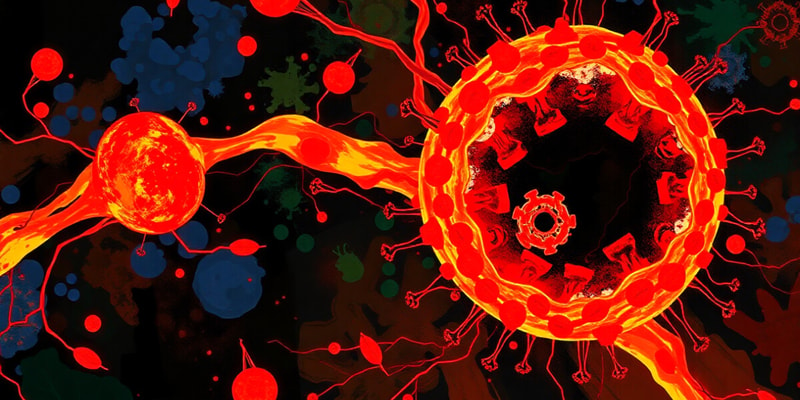Podcast
Questions and Answers
What is the primary purpose of inflammation in living tissues?
What is the primary purpose of inflammation in living tissues?
Which of the following best describes inflammation?
Which of the following best describes inflammation?
What effect do soluble factors produced by various cells have during inflammation?
What effect do soluble factors produced by various cells have during inflammation?
What is a negative consequence of inflammation, identified as a potential drawback?
What is a negative consequence of inflammation, identified as a potential drawback?
Signup and view all the answers
Which of the following causes of inflammation is considered a physical agent?
Which of the following causes of inflammation is considered a physical agent?
Signup and view all the answers
Which of the following is NOT a benefit of the inflammatory response?
Which of the following is NOT a benefit of the inflammatory response?
Signup and view all the answers
Inflammation primarily occurs in what type of living tissues?
Inflammation primarily occurs in what type of living tissues?
Signup and view all the answers
Which statement about the historical perspective on inflammation is accurate?
Which statement about the historical perspective on inflammation is accurate?
Signup and view all the answers
Which of the following best describes acute inflammation?
Which of the following best describes acute inflammation?
Signup and view all the answers
What causes the redness associated with acute inflammation?
What causes the redness associated with acute inflammation?
Signup and view all the answers
Phagocytosis involves which of the following processes?
Phagocytosis involves which of the following processes?
Signup and view all the answers
Which of the following chemical mediators is NOT typically involved in acute inflammation?
Which of the following chemical mediators is NOT typically involved in acute inflammation?
Signup and view all the answers
What is the primary leukocyte type that migrates to the site of acute inflammation during the initial response?
What is the primary leukocyte type that migrates to the site of acute inflammation during the initial response?
Signup and view all the answers
How is swelling in acute inflammation primarily caused?
How is swelling in acute inflammation primarily caused?
Signup and view all the answers
Which suffix is commonly used to indicate an inflammatory lesion?
Which suffix is commonly used to indicate an inflammatory lesion?
Signup and view all the answers
What process describes the movement of leukocytes out of the bloodstream and into the inflamed tissue?
What process describes the movement of leukocytes out of the bloodstream and into the inflamed tissue?
Signup and view all the answers
What is the primary role of exudate during acute inflammation?
What is the primary role of exudate during acute inflammation?
Signup and view all the answers
Which of the following is NOT an outcome of acute inflammation?
Which of the following is NOT an outcome of acute inflammation?
Signup and view all the answers
How does exudate promote microbial destruction during inflammation?
How does exudate promote microbial destruction during inflammation?
Signup and view all the answers
What detrimental effect can acute inflammation have on tissue?
What detrimental effect can acute inflammation have on tissue?
Signup and view all the answers
Which system is NOT mentioned as being provided to the area of injury during inflammation?
Which system is NOT mentioned as being provided to the area of injury during inflammation?
Signup and view all the answers
In chronic inflammation, what processes are occurring simultaneously?
In chronic inflammation, what processes are occurring simultaneously?
Signup and view all the answers
What is a potential mechanical consequence of inflammation in certain locations?
What is a potential mechanical consequence of inflammation in certain locations?
Signup and view all the answers
What is a key factor in the progression from acute to chronic inflammation?
What is a key factor in the progression from acute to chronic inflammation?
Signup and view all the answers
Which type of chronic inflammation is characterized by the presence of granulomas?
Which type of chronic inflammation is characterized by the presence of granulomas?
Signup and view all the answers
Which of the following is NOT a cause of chronic inflammation?
Which of the following is NOT a cause of chronic inflammation?
Signup and view all the answers
Which cells are predominantly involved in chronic inflammation?
Which cells are predominantly involved in chronic inflammation?
Signup and view all the answers
Which of the following best describes nonspecific chronic inflammation?
Which of the following best describes nonspecific chronic inflammation?
Signup and view all the answers
Chronic inflammation following acute inflammation usually results from which condition?
Chronic inflammation following acute inflammation usually results from which condition?
Signup and view all the answers
Epithelioid cells, involved in granulomatous inflammation, are derived from which cell type?
Epithelioid cells, involved in granulomatous inflammation, are derived from which cell type?
Signup and view all the answers
What type of substance can cause chronic inflammation through prolonged exposure?
What type of substance can cause chronic inflammation through prolonged exposure?
Signup and view all the answers
Which of the following diseases is classified as a chronic inflammation from the onset?
Which of the following diseases is classified as a chronic inflammation from the onset?
Signup and view all the answers
Which of the following is NOT a major cause of granulomatous inflammation?
Which of the following is NOT a major cause of granulomatous inflammation?
Signup and view all the answers
What constitutes the primary systemic manifestation of inflammation?
What constitutes the primary systemic manifestation of inflammation?
Signup and view all the answers
Which of the following cytokines is NOT mentioned as being involved in the coordination of fever?
Which of the following cytokines is NOT mentioned as being involved in the coordination of fever?
Signup and view all the answers
What is the typical leukocyte count indicating leukocytosis in bacterial infections?
What is the typical leukocyte count indicating leukocytosis in bacterial infections?
Signup and view all the answers
Which endocrine response involves increased secretion of glucocorticoids during inflammation?
Which endocrine response involves increased secretion of glucocorticoids during inflammation?
Signup and view all the answers
Which type of response involves rerouting blood flow during inflammation?
Which type of response involves rerouting blood flow during inflammation?
Signup and view all the answers
Which of the following represents an effect of IL-1 during inflammation?
Which of the following represents an effect of IL-1 during inflammation?
Signup and view all the answers
In which condition is leukopenia typically observed?
In which condition is leukopenia typically observed?
Signup and view all the answers
Study Notes
Inflammation Overview
- Inflammation is derived from the Latin word "inflammare," meaning "to burn."
- It's a local response (reaction) of living vascularized tissues to endogenous and exogenous stimuli.
- The fundamental purpose of inflammation is to localize and eliminate the causative agent, limiting tissue injury.
- Inflammation is a protective response to injury, identified by Sir John Hunter in 1794. It isn't a disease itself, but a necessary process following injury or disease.
Causes of Inflammation
- Physical agents: Mechanical injuries, temperature changes, pressure, and radiation.
- Chemical agents: Drugs and toxins.
- Biological agents (infectious): Bacteria, viruses, fungi, and parasites.
- Immunologic disorders: Hypersensitivity reactions, autoimmunity, and immunodeficiency states.
- Genetic/metabolic disorders: Gout and diabetes mellitus.
Cardinal Signs of Inflammation
- Redness (rubor): Due to dilation of small blood vessels in damaged tissue, like cellulitis.
- Heat (calor): From increased blood flow (hyperemia) due to regional vasodilation.
- Swelling (tumor): Due to fluid accumulation in the extravascular space from increased vascular permeability.
- Pain (dolor): From tissue stretching and destruction, and chemicals like bradykinins, prostaglandins, and serotonin.
- Loss of function: The inflamed area is inhibited by pain or physically immobilized by swelling.
Definition of Inflammation
- Inflammation is defined as a complex systemic biological response of vascular living tissues to harmful stimuli like pathogens, damaged cells, or irritants.
- It's a protective mechanism aiming to remove injurious stimuli and initiate the healing process of the tissue.
- Mainly involves responses of blood vessels and leukocytes (white blood cells).
- Cellular and vascular reactions are triggered by soluble factors from cells, or plasma proteins, generated in response to the inflammatory stimulus.
Why Inflammation? Benefits
- Identification of the injurious stimuli.
- Curtailment of the progression of the injurious agent.
- Dilution of toxins produced by the injurious agent.
- Destruction/degradation of the injurious agent and preparation of the tissue for repair.
Why Inflammation? Harmful Effects
- Inflammation can lead to tissue necrosis.
- Swelling can cause mechanical interference in certain locations (e.g., epiglottitis, meningitis).
- Hypersensitivity reactions can cause an inappropriate, exaggerated inflammatory response.
Outcomes of Acute Inflammation
- Complete resolution.
- Healing by connective tissue replacement.
- Progression to chronic inflammation.
- Abscess formation.
Chronic Inflammation
- A prolonged inflammatory process lasting weeks or months.
- Involves active inflammation, tissue destruction, and attempts at repair occurring simultaneously.
Causes of Chronic Inflammation
- Persistent infections (e.g., tuberculosis, leprosy).
- Prolonged exposure to non-degradable but partially toxic substances (e.g., endogenous lipid components, silica, asbestos).
- Progression from acute inflammation (e.g., uncollapsed abscess cavities, foreign bodies).
- Autoimmunity (e.g., rheumatoid arthritis, systemic lupus erythematosus).
Cells in Chronic Inflammation
- Monocytes and macrophages.
- T-lymphocytes.
- B-lymphocytes and plasma cells.
- Mast cells and eosinophils (primarily in response to parasitic infestations or allergic reactions).
Classification of Chronic Inflammation
- Nonspecific chronic inflammation: Characterized by a diffuse accumulation of macrophages and lymphocytes at the site of injury, often with new fibrous tissue formations (e.g., chronic cholecystitis).
- Specific (granulomatous) chronic inflammation: Characterized by the presence of granulomas—microscopic aggregates of activated macrophages (epithelioid cells) with modified epithelial cell-like appearance.
Causes of Granulomatous Inflammation
- Bacterial (e.g., tuberculosis, leprosy, syphilis).
- Fungal (e.g., histoplasmosis, cryptococcosis).
- Helminthic (e.g., schistosomiasis).
- Protozoal (e.g., leishmaniasis).
- Chlamydia (e.g., lymphogranuloma venereum).
- Inorganic material (e.g., beryllium).
Systemic Effects of Inflammation
- Fever.
- Endocrine and metabolic responses (e.g., liver secreting acute-phase proteins like C-reactive protein, serum amyloid A, complement and coagulation proteins, increased glucocorticoids, decreased vasopressin).
- Autonomic responses (e.g., redirection of blood flow to deeper vascular beds, increased pulse and blood pressure).
- Behavioral responses (e.g., rigor, chills, anorexia, somnolence, and malaise).
- Leukocytosis/Leukopenia (increase/decrease in white blood cell count).
- Weight loss.
Cellular response to acute inflammation
- Migration, rolling, pavementing, and adhesion of leukocytes
- Transmigration of leukocytes
- Chemotaxis (leukocytes to inflammation site)
- Phagocytosis
###Nomenclature
- Inflammatory lesions typically indicated by the suffix "-itis". (eg appendicitis, meningitis).
Studying That Suits You
Use AI to generate personalized quizzes and flashcards to suit your learning preferences.
Related Documents
Description
Explore the critical aspects of inflammation, including its definition, causes, and cardinal signs. Learn how this protective response helps localize and eliminate harmful stimuli while understanding its importance in the body's healing process.





